What would have happened if Romania did not unify as Romania Mare in 1918?
Date: Sat Mar 27 2021 ; Tags:
In WWII Romania played a significant if little recognized role. It began World War II when Russia annexed Bessarabia (which is part of Moldova) and Hungary annexed part of Transylvania. Quickly, Romania joined the Axis Powers, supplying oil to the Nazi War Machine, and Romanian troops participated in the invasion of the Soviet Union and the Battle of Stalingrad. Later, Romania flipped sides, joining the Allied Powers, with its troops fighting alongside the Soviets, which hastened the end of WWII. In other words, Romania greatly helped both the Axis and the Allied powers. Its ability to do all that was partly due to having become a relatively large country following WWI. The period between WWI and WWII is called Romania Mare, as it was first time in history that ethnic Romanians were ruled by a single Romanian government. But what if they'd been unable to form Romania Mare?
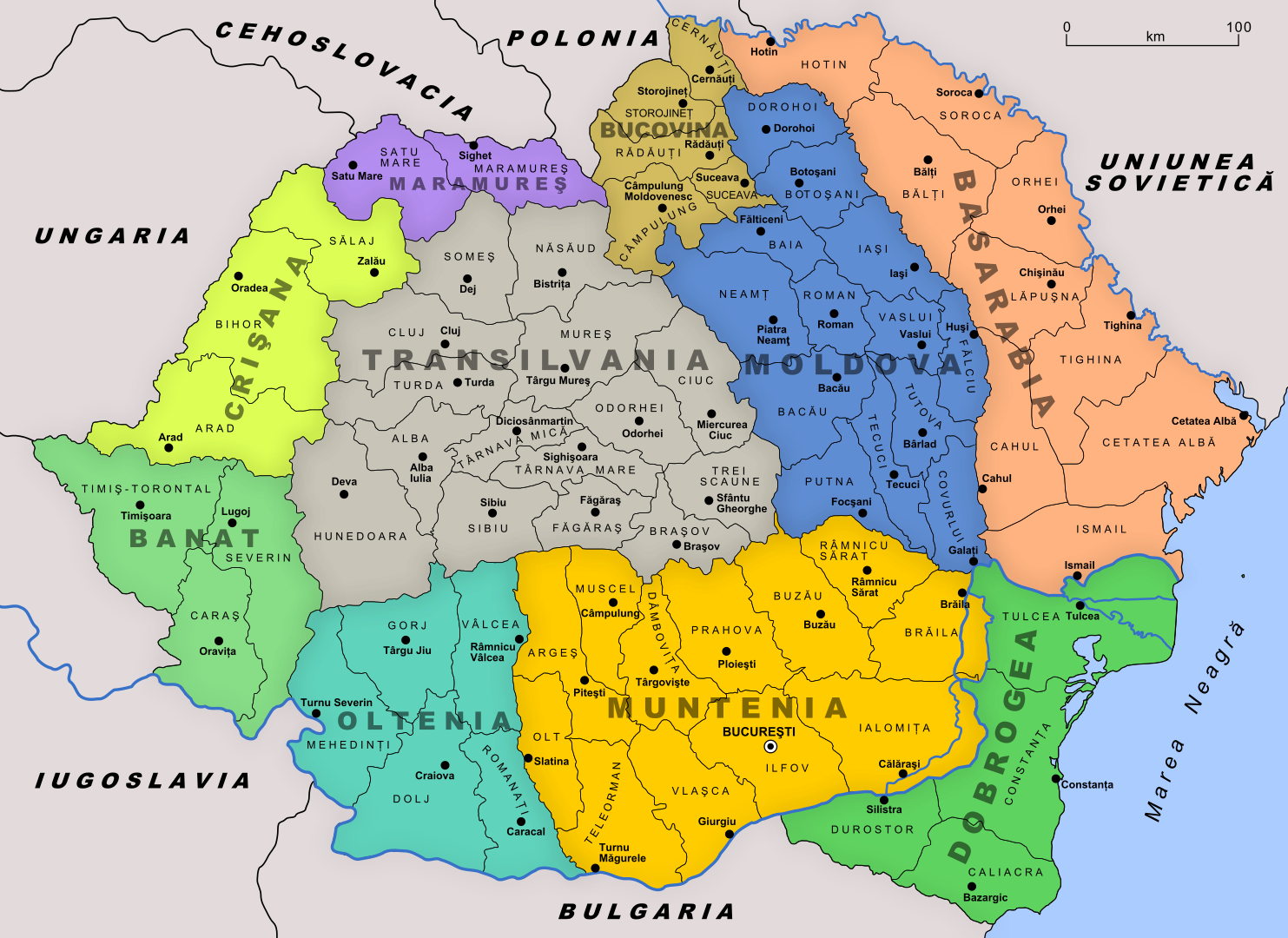
Romania Mare was a dream by some Romanian politicians starting in the 1800's. The stated goal was uniting all Romanian peoples into one nation. This is an example of ethnocentric nationalism, where each racial group has its own territory and governing body.
For a complete writeup, see:
One definition spoken by Romanian populations is that it would include the territories between the Dniester River, the Black Sea, the Danube River, and the Tisza River. The problem with that boundary is that the Tisza River is deep inside Hungary, and is surrounded by a clear majority Hungarian population. The more practical definition of Romania Mare is the borders Romania had following World War I, shown in the map above, due to the Treaty of Trianon.
That map shows Romania's borders from 1919 to 1940. This included all of Moldova, to the Dniester River, all of Bukovina, all of Dobrogia, and a western border which coincides with where the population switches from majority Romanian to majority Hungarian. The border isn't perfect since there are multiple ethnicities inside Romanian territory.
Before these boundaries were established at the end of World War I, Romania was a much smaller Kingdom:
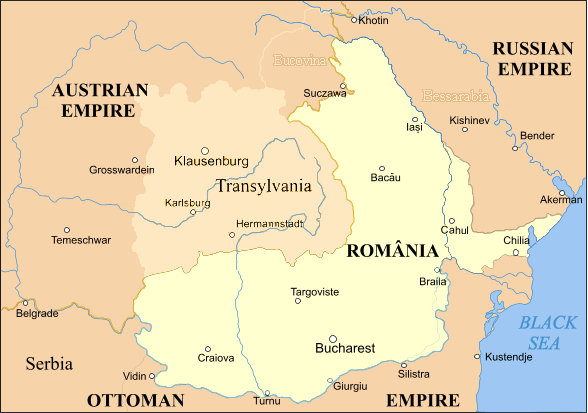
The Kingdom of Romania was founded in the 1880's, uniting Wallachia and part of Moldova into one political unit. As modest as this was, it was a big advance over the many centuries that Romanians were split into three primary regions (Wallachia, Transylvania, and Moldova) which were frequently ruled by outsiders.
To continue setting the scene, consider this map:
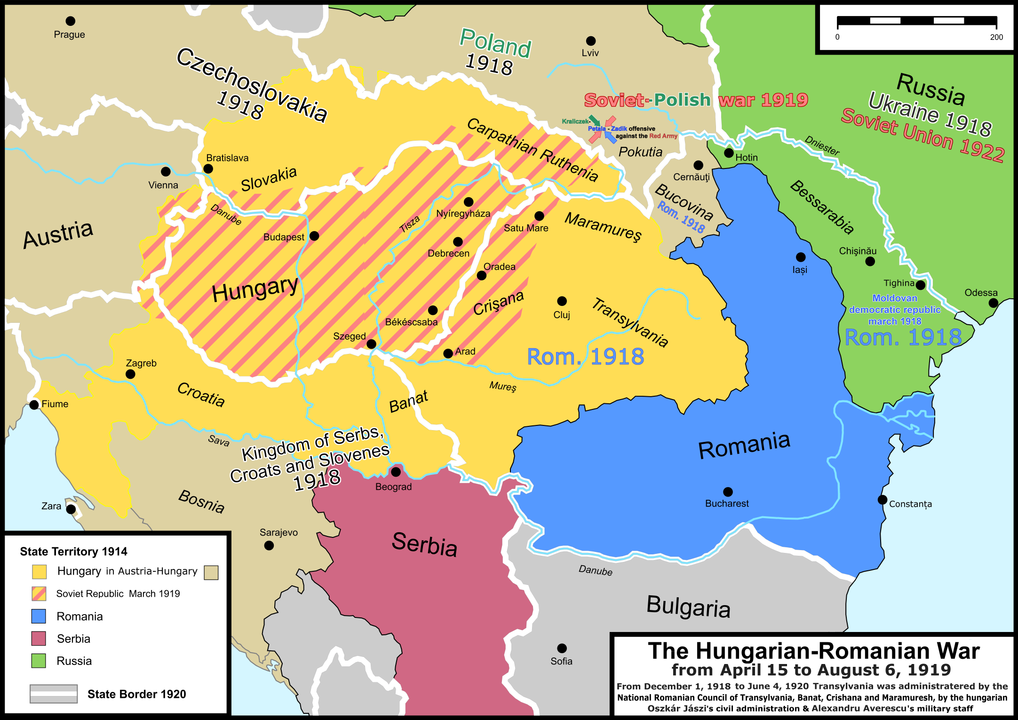
At the end of World War I, territories were in flux and there were several conflicts still underway. For example the Russian Empire underwent a revolution that resulted in the formation of the Communist Soviet Union. The map describes a war between the Soviet Union and Poland. Then there was the issue of Hungary's rule over Transylvania, and the attempt to convert Hungary into a Communist Soviet Republic.
Romania was nearly destroyed by World War I, and was forced into a disadvantageous treaty with the German-Austrian-Hungarian powers. That treaty would have consigned Romania to, more or less, the blue territory on this map. However, afterwards the German-Austrian-Hungarian powers collapsed and ended up on the losing side of the war.
Romania took the initiative and moved troops into Bessarabia, Bukovina, Maramures, Transylvania and The Banat. Further, when Hungarian politicians attempted convert it into a Soviet state, Romania (along with other powers) sent in troops which took down the Communist government.
But at the end of all this, what determined Romania's final borders was the Great Powers who met at the Paris Peace Conference. It was the USA, Great Britain, France, and Italy, as the victors, who redrew the borders of Europe.
The question is, what would have been the result if the Great Powers had decided different boundaries for Romania after World War I?
After World War I, there are at least three scenarios where Romania would have ended up with significantly less territory. Bessarabia might have stayed with the Soviet Union, since the Russian Empire had ruled that land for over 100 years. The Ukrainians in Bukovina might have successfully objected to how Romania took control over that region. The Hungarians might have successfully argued that some or all of Transylvania stay with Hungary.
What if Bessarabia had not united with Romania after World War I
Bessarabia is the territory between the Prut and Dniester Rivers. It was historically a part of the Principality of Moldova from time immemorial. But in 1812, the Russian Empire took control over that territory. That began a period of Russification during which the Empire enacted policies meant to erase the Romanian language and culture from the people, replacing it with Russian, and also colonizing the territory with Russians and Ukrainians.
If Bessarabia had joined the Soviet Union after WWI, Romania would have had 45,630 square kilometers (17,620 sq mi) less territory, and a couple million fewer people. In 1940 when the Soviet Union annexed Bessarabia, would it instead have annexed the rest of Moldova?
Culturally, the Russian Empire's rule over Bessarabia was hard on Romanians.
| Census | Population | Romanians (Moldavians) | Ukrainians and Russians | Jews |
|---|---|---|---|---|
| 1817 | 482,630 | 86% (est.) | 6.5% (est.) | 4.2% (est.) |
| 1856 | 990,000 | 74% | 12% | 8% |
| 1897 | 1,935,412 | 56% | 18.9% | 11.7% |
While the population significantly increased, the percentage of Romanians shrank. Further, the Russification policies meant:
- The Romanian language was no longer taught in schools.
- The churches were placed under the Russian Orthodox hierarchy, and services were in Russian.
- Government business was conducted in Russian.
- Newspapers were written in Russian.
Since many Romanians in Moldova refused to educate their children in Russian-led schools, the literacy rate fell drastically.
After World War II when Bessarabia was taken from Romania, the USSR reestablished it as the Moldova Soviet Socialistic Republic. The USSR instituted many of the same Russification policies, and added the requirement that Romanian words be spelled with Cyrillic letters, and created a mythical Moldovan cultural identity that was supposedly distinct from Romanian.
In other words, had Bessarabia joined the Soviet Union in 1919, rather than joining the Kingdom of Romania, the Russification policies obviously would have continued. Just as happened in Belarus, where the Belarusian language is hard to find, the Romanian language might today be hard to find in Moldova.
Even today, in 2021, almost 30 years after the Republic of Moldova became an independent country, the Russian culture and Russian language plays a significant role. Most or all the television stations are Russian owned, using the Russian language. There are two Orthodox hierarchies in Moldova, one deriving from the Russian Orthodox Church, the other from the Romanian Orthodox Church. Moldovan politics is dominated by Russian affiliated politicians. And, Russia maintains an army in the breakaway region of Transnistria, where the Russian culture holds even more sway.
What if Bukovina had gone with the Soviet Union after World War I
In November 1918 the collapse of the Kingdom of Hungary caused its neighbors to move into territories containing non-Hungarian ethnicities. For example Czech's and Ukrainians moved into the Carpathian Ruthenia, while in the south Croatia broke off completely to form a Kingdom with the Serbians and Slovenians.
On November 4, Ukrainians took control Czernowitz (now known as Chernivsti), the largest city in Bukovina. Then on November 10, Romania declared war, and on November 12 Czernowitz was siezed by the Romanian Army, and the Romanian National Council was established. By November 28, the Romanian National Council convened the General Congress of Bukovina, which formally issued a requested the union of Bukovina with The Kingdom of Romania. On December 19, the Romanian government formally issued a decree annexing Bukovina.
But the Ukrainian deputies (38% of the population) and Jewish deputies did not attend that General Congress.
To see why, let's look at the ethnicity:
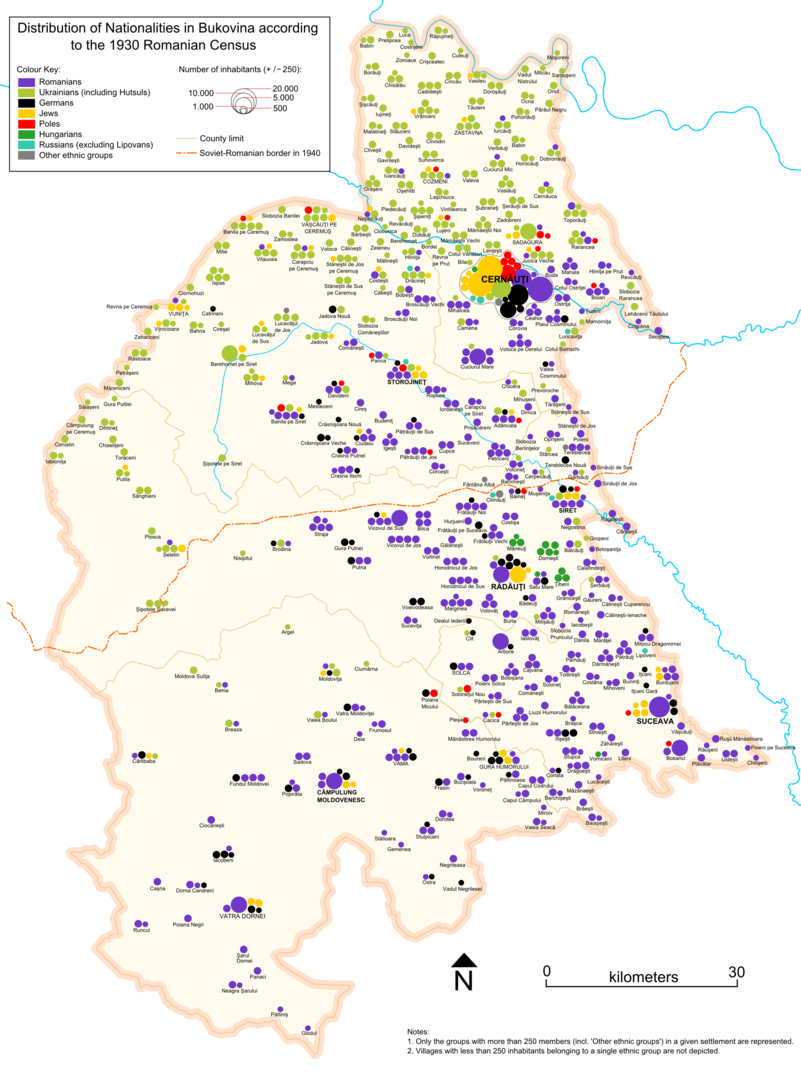
In other words, most of North Bukovina is mostly Ukrainian, and the southern part is mostly Romanian. Cernauti, as it's shown on this map, is a melting pot of different cultures.
Taken as a timeline, the events leading to the Romanian takeover of Bukovina look like Romania ram-rodding a given result. However, it's clear from this map that the majority of the territory in question was occupied by ethnic Romanians. Further, at the Congress the Romanians argued, correctly, that until the Hapsburg takeover of Bukovina in 1775, the province had been a key part of the Principality of Moldova. For example, Cernauti is where the Voivode's of Moldova are buried.
While the actual result, that Romania takes over Bukovina, is the overwhelmingly likely result, it's possible that some or all of the territory might have joined the Soviet Union. If that had happened, it seems the effect on Romania would have been minor, given the small amount of territory and population.
However, there is also the issue of Russification. When the USSR annexed north Bukovina from Romania, they deported tens of thousands of Romanians to Siberia, killed others outright, and even deported ethnic Germans to Germany.
What if parts of Transylvania had stayed with Hungary after World War I
During WWI there were two Treaty's of Bucharest that were very different. The first, the 1916 Treaty of Bucharest, was signed with The Entente (England, France, Italy, Russia) and promised Romania large territorial gains. The second, in 1918, was signed with the Central Powers (Germany, Austria-Hungary) after they nearly destroyed Romania. The Kingdom of Romania had retreated to a small portion of Moldova centered on Iasi, and would have disappeared but for the support of the Russian Empire. But when the Russian Revolution began, that support dissolved, and Romania was forced to capitulate to the Central Powers. This second treaty limited Romania to the following territory:
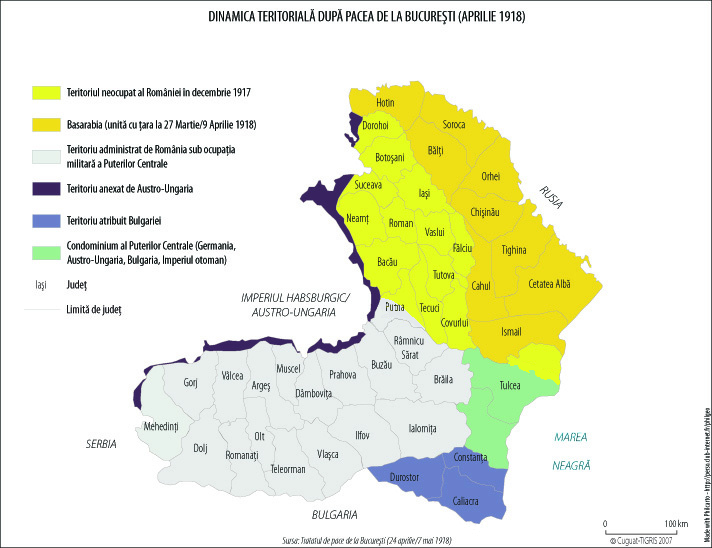
This more-or-less matches the pre-WWI Kingdom of Romania as shown above.
This territory is one of the possible post-WWI boundaries of Romania. Indeed, the Paris Peace Conference seems to have desired to hold Romania to the territory outlined in the 1918 Treaty of Bucharest. But through a combination of diplomacy and declarations from local populations of the desire to unite with Romania, the final treaty (Treaty of Trianon) gave Romania the Romania Mare territory shown earlier.
Another possible post-WWI boundary is to give Romania most of Transylvania, but to give Hungary the parts that have significant Hungarian populations. There is a large cluster of Hungarians, the Szekeley's, deep inside Transylvania, with hundreds of years of history behind them.
Consider these two maps:
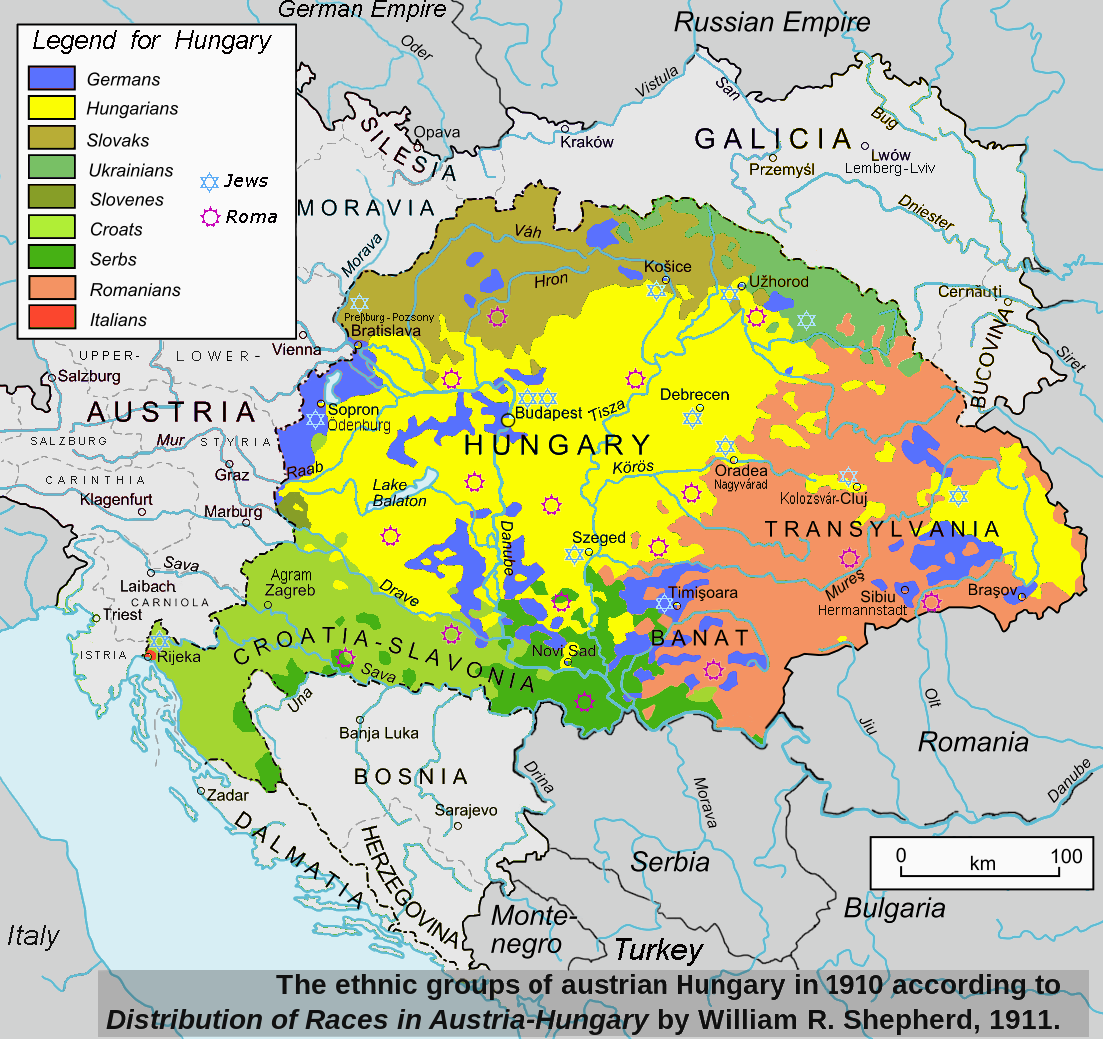
|
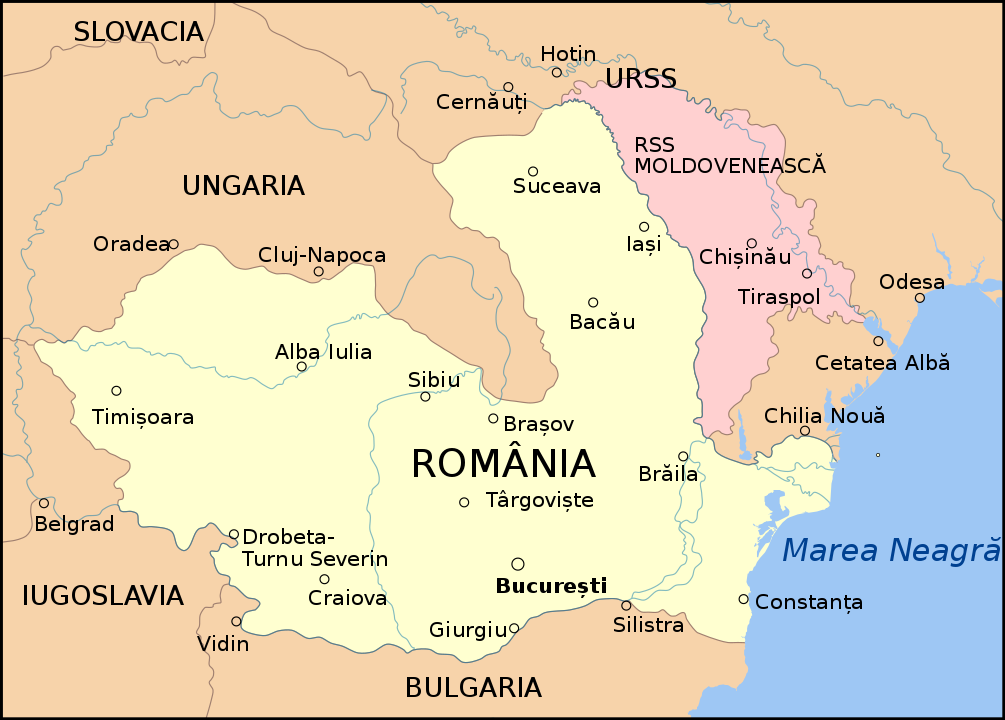
|
The first shows ethnic distributions in the Kingdom of Hungary before WWI. It demonstrates the spread of Hungarians in Transylvania, which might have given justification to grant Hungary a sliver of Transylvanian territory, even if Romania was awarded the rest.
The second map shows the actual territory changes to Romania at the beginning of World War I. The first change was when Russia demanded Bessarabia and northern Bukovina. The second change occurred when Hungary petitioned Nazi Germany for a sliver of land in Transylvania due to the Hungarian populations.
In other words, it's possible the Paris Peace Conference in 1919-1920 could have chosen a similar distribution of land between Romania and Hungary. What would the impact on Romania have been if the Paris Peace Conference took either of these routes?
In 1919-1920, if the Paris Peace Conference had awarded some or all of Transylvania to Hungary, then Romania's territory and population would not have grown as much as it did. Romania would have been a weaker country, as a result. The status of Romanians in Transylvania under Hungarian rule is well known, since Romanians were for hundreds of years relegated to a second-class role.
In other words, like the Russification process in Moldova and north Bukovina, there was a Magyarization process in Transylvania. The Hungarians were seemingly more accommodating of there being multiple cultures within the Kingdom of Hungary than the Russian Empire was of non-Russian cultures. But there was a Magyarization process nonetheless.
Summary
It's always difficult to engage in speculative What If interpretations of history. We can't be certain of how things would have turned out had events taken a different turn.
In this case we are able to deduce the likely results from the events surrounding World War II. Romania did lose a significant amount of territory, some of which it has not regained even 70 years later, and the lost territories correspond to the lands where the Romanian claim was the weakest. Rightly or wrongly, these territorial truths existed:
- The Russian Empire did rule Bessarabia for most of the 1800's.
- The Kingdom of Hungary did rule Transylvania for hundreds of years.
- The Szekley population is strongly entrenched in Transylvania, with hundreds of years of history.
- The Hapsburg Empire did conquer Bukovina in 1775, and they did introduce folks of other ethnicities.
- Ethnic Germans have lived in Transylvania for hundreds of years.
The actual results of the Paris Peace Conference awarded Romania most of the territories containing Romanian speaking populations. But, as is true all across Europe, the dividing lines of which ethnicity lives where is not clean. The ethnographic map of the Kingdom of Hungary should make that clear, if you study the locations for clusters of different ethnic groups.
The history of this area is full of ethnic conflicts, even today (2021). Some of the Hungarians in Transylvania want a degree of local autonomy. In northern Bukovina, the ethnic Romanians are a suppressed minority. In Moldova, the Russian influence is still strong 30 years after the Soviet Union disintegrated. Other than that, the population of Romania is strongly tilted to ethnic Romanians.
comments powered by Disqus